Implementation and Experimental Validation of Efficiency Improvement in PM Synchronous Hub Motors for Light Electric Vehicles †
Abstract
1. Introduction
2. Design Optimization of a PM Synchronous Hub Motor
2.1. Determining the Motor Sizing and Power
2.2. Selecting the Number of Poles and Slot
3. Design Optimization of the PMSHM
3.1. Design Optimization of the Rotor
3.1.1. Skewing the Rotor Magnets
3.1.2. Reducing Eddy-Current Losses in Magnets
3.1.3. Optimization of the Magnet Thickness
3.1.4. Optimization of the Air Gap Length
3.1.5. Optimization of the Rotor’s Thickness
3.2. Design Optimization of the Stator
3.2.1. Selecting the Stator Winding Structure
3.2.2. Selection of the Stator Sheet Material
3.2.3. Stator Slot Design
3.2.4. Improving the Production Accuracy by Wire-Erosion Cutting
4. Optimization Design Results
5. Prototyping and Testing of The Motor
5.1. Stator Production
- -
- Demagnetization temperature of N52M series Magnets is 100 C.
- -
- Class C insulation material thermal limit of the windings is 220 C.
- -
- The thermal limit of the stator insulation paper is 180 C.
5.2. Rotor Production
5.3. The Motor Testing and Results
6. Conclusions
Author Contributions
Funding
Acknowledgments
Conflicts of Interest
References
- Celtek, S.A. Effects of electric motors on the energy efficiency. In Proceedings of the 8th International Ege Energy Symposium & Exhibition, Karahisar, Turkey, 11–13 May 2015. [Google Scholar]
- Dambrauskas, K.; Vanagas, J.; Zimnickas, T.; Kalvaitis, A.; Ažubalis, M. A method for efficiency determination of permanent magnet synchronous motor. Energies 2020, 13, 1004. [Google Scholar] [CrossRef]
- Jiang, X.; Chen, L.; Xu, X.; Cai, Y.; Li, Y.; Wang, W. Analysis and optimization of energy efficiency for an electric vehicle with four independent drive in-wheel motors. Adv. Mech. Eng. 2018, 10, 1687814018765549. [Google Scholar] [CrossRef]
- Loganayaki, A.; Kumar, R.B. Permanent magnet synchronous motor for electric vehicle applications. In Proceedings of the 2019 5th International Conference on Advanced Computing & Communication Systems (ICACCS), Coimbatore, India, 15–16 March 2019; pp. 1064–1069. [Google Scholar] [CrossRef]
- Gieras, J.F. Analytical approach to cogging torque calculation in PM brushless motors. In Proceedings of the IEEE International Electric Machines and Drives Conference, IEMDC’03, Madison, WI, USA, 1–4 June 2003; Volume 2, pp. 815–819. [Google Scholar] [CrossRef]
- Saied, S.A.; Abbaszadeh, K. Cogging torque reduction in brushless DC motors using slot-opening shift. Adv. Electr. Comput. Eng. 2009, 9, 28–33. [Google Scholar] [CrossRef]
- Dal, Ö.; Yıldırım, M.; Kürüm, H. Optimization of permanent magnet synchronous motor design by using PSO. In Proceedings of the 2019 4th International Conference on Power Electronics and their Applications (ICPEA), Elazig, Turkey, 25–27 September 2019; pp. 1–6. [Google Scholar] [CrossRef]
- Kawase, Y.; Yamaguchi, T.; Tu, Z.; Toida, N.; Minoshima, N.; Hashimoto, K. Effects of skew angle of rotor in squirrel-cage induction motor on torque and loss characteristics. IEEE Trans. Magn. 2009, 45, 1700–1703. [Google Scholar] [CrossRef]
- Libert, F.; Soulard, J. Investigation on pole-slot combinations for permanent-magnet machines with concentrated windings. In Proceedings of the International Conference on Electrical Machines and Systems 2004, Lodz, Poland, 1–3 November 2004; pp. 5–8. [Google Scholar]
- Jacek, F. Gieras “Permanent Magnet Motor Technology”, 3rd ed.; CRC Press: Boca Raton, FL, USA, 2010; ISBN 978-1420064407. [Google Scholar]
- Zhu, Z.Q.; Howe, D. Influence of design parameters on cogging torque in permanent magnet machines. IEEE Trans. Energy Convers. 2000, 15, 407–412. [Google Scholar] [CrossRef]
- Jiang, X.; Chen, L.; Xu, X.; Cai, Y.; Li, Y.; Wang, W. Design optimisation of an outer-rotor permanent magnet synchronous hub motor for a low-speed campus patrol EV. IET Electr. Power Appl. 2020, 14, 2111–2118. [Google Scholar] [CrossRef]
- Lee, J.Y.; Woo, B.C.; Kim, J.M.; Oh, H.S. In-wheel motor design for an electric scooter. J. Electric. Eng. Technol. 2017, 12, 2307–2316. [Google Scholar] [CrossRef]
- Song, B.; Choi, J. A low-speed high-torque permanent magnet motor for electric scooters. In Proceedings of the 2011 IEEE Vehicle Power and Propulsion Conference, Chicago, IL, USA, 6–9 September 2011; pp. 1–6. [Google Scholar] [CrossRef]
- Tariq, A.R.; Nino-Baron, C.E.; Strangas, E.G. Consideration of magnet materials in the design of PMSMs for HEVs application. IEEE Power Energy Soc. Gen. Meet. 2011, 2011, 6039824. [Google Scholar] [CrossRef]
- Hiron, N.; Andang, A.; Busaeriet, N. Investigation of NdFeB N52 magnet field as advanced material at air gap of axial electrical generator. IOP Conf. Ser. Mater. Sci. Eng. 2019, 550, 012034. [Google Scholar] [CrossRef]
- Martínez, D. Design of a Permanent-Magnet Synchronous Machine with Non-Overlapping Concentrated Windings for the Shell Eco Marathon Urban Prototype (Dissertation). 2012. Available online: http://urn.kb.se/resolve?urn=urn:nbn:se:kth:diva-109741 (accessed on 16 October 2022).
- Li, L.; Zhang, J.; Zhang, C.; Yu, J. Research on electromagnetic and thermal issue of high efficiency and high-power density outer-rotor motor. IEEE Trans. Appl. Supercond. 2016, 26, 1–5. [Google Scholar] [CrossRef]
- Sudha, B.; Vadde, A.; Sachin, S. A review: High power density motors for electric vehicles. In Proceedings of the Journal of Physics: Conference Series, Volume 1706, First International Conference on Advances in Physical Sciences and Materials, Coimbatore, India, 13–14 August 2020. [Google Scholar]
- Hanselman, D.C. Brushless Permanent Magnet Motor, 2nd ed.; The Writers’ Collective: Cranston, RI, USA, 2003; ISBN 978-1932133639. [Google Scholar]
- Hwang, C.C.; Wu, M.H.; Cheng, S.P. Influence of pole and slot combinations on cogging torque in fractional slot PM motors. J. Magn. Magn. Mater. 2006, 304, e430–e432. [Google Scholar] [CrossRef]
- Sayed, A.E.; Erturk, E. Minimizing cogging torque in permanent magnet synchronous generators for small wind turbine applications. Int. J. Renew. Energy Res. 2021, 11, 691–700. [Google Scholar]
- Hsiao, C.; Yeh, S.; Hwang, J. A novel cogging torque simulation method for permanent-magnet synchronous machines. Energies 2011, 4, 2166–2179. [Google Scholar] [CrossRef]
- Islam, R.; Husain, I.; Fardoun, A.; McLaughlin, K. Permanent-magnet synchronous motor magnet designs with skewing for torque ripple and cogging torque reduction. IEEE Trans. Ind. Appl. 2009, 45, 152–160. [Google Scholar] [CrossRef]
- Dalcalı, A.; Kurt, E.; Çelik, E.; Öztürk, N. Cogging torque minimization using skewed and separated magnet geometries. J. Polytech. 2020, 23, 223–230. [Google Scholar] [CrossRef]
- Nam, D.-W.; Lee, K.-B.; Pyo, H.-J.; Jeong, M.-J.; Yang, S.-H.; Kim, W.-H.; Jang, H.-K. A study on core skew considering manufacturability of double-layer spoke-type PMSM. Energies 2021, 14, 610. [Google Scholar] [CrossRef]
- Jagadeeshwaran, A.; Padma, S. Comparative study of cogging torque for different tooth gap width and airgap flux of PMBLDC motor for motion control applications. Int. J. Electr. Eng. 2012, 5, 783–790. [Google Scholar]
- Fernandez, D.; Reigosa, D.; Guerrero, J.M.; Zhu, Z.Q.; Suarez, C.; Briz, F. Influence of PM coating on PM magnetization state estimation methods based on magnetoresistive effect. IEEE Trans. Ind. Appl. 2018, 54, 2141–2150. [Google Scholar] [CrossRef]
- Lee, H.; Neville, K. Handbook of Epoxy Resins, 1st ed.; McGraw-Hill: New York, NY, USA, 1967; ISBN 978-0070369979. [Google Scholar]
- Lateb, R.; Takorabet, N.; Meibody-Tabar, F. Effect of magnet segmentation on the cogging torque in surface-mounted permanent-magnet motors. IEEE Trans. Magn. 2006, 42, 442–445. [Google Scholar] [CrossRef]
- Hong, D.-K.; Lee, T.-W.; Jeong, Y.-H. Design and Experimental Validation of a High-Speed Electric Turbocharger Motor Considering Variation of the L/D Ratio. IEEE Trans. Magn. 2018, 54, 1–4. [Google Scholar] [CrossRef]
- Novak, G.; Kokošar, J.; Nagode, A.; Petrovic, D.S. Core-loss prediction for non-oriented electrical steels based on the Steinmetz equation using fixed coefficients with a wide frequency range of validity. IEEE Trans. Magn. 2014, 51, 1–7. [Google Scholar] [CrossRef]
- Yoshihiko, O.; Masaaki, O.T.T. Recent Development of Non-Oriented Electrical Steel in JFE Steel. JFE Tech. Rep. 2016, 21, 7–13. [Google Scholar]
- Garip, S.; Yasa, Y. Design of outer runner-type brushless permanent magnet DC motor for light-weight E-vehicles. In Proceedings of the 2020 6th International Conference on Electric Power and Energy Conversion Systems (EPECS), Istanbul, Turkey, 5–7 October 2020; pp. 151–156. [Google Scholar] [CrossRef]
- Abhilash, D.S.H.; Wani, I.; Joseph, K.; Jha, R.; Haneesh, K.M. Power efficient e-bike with terrain adaptive intelligence. In Proceedings of the 2019 International Conference on Communication and Electronics Systems (ICCES), Coimbatore, India, 17–19 July 2019; pp. 1148–1153. [Google Scholar] [CrossRef]
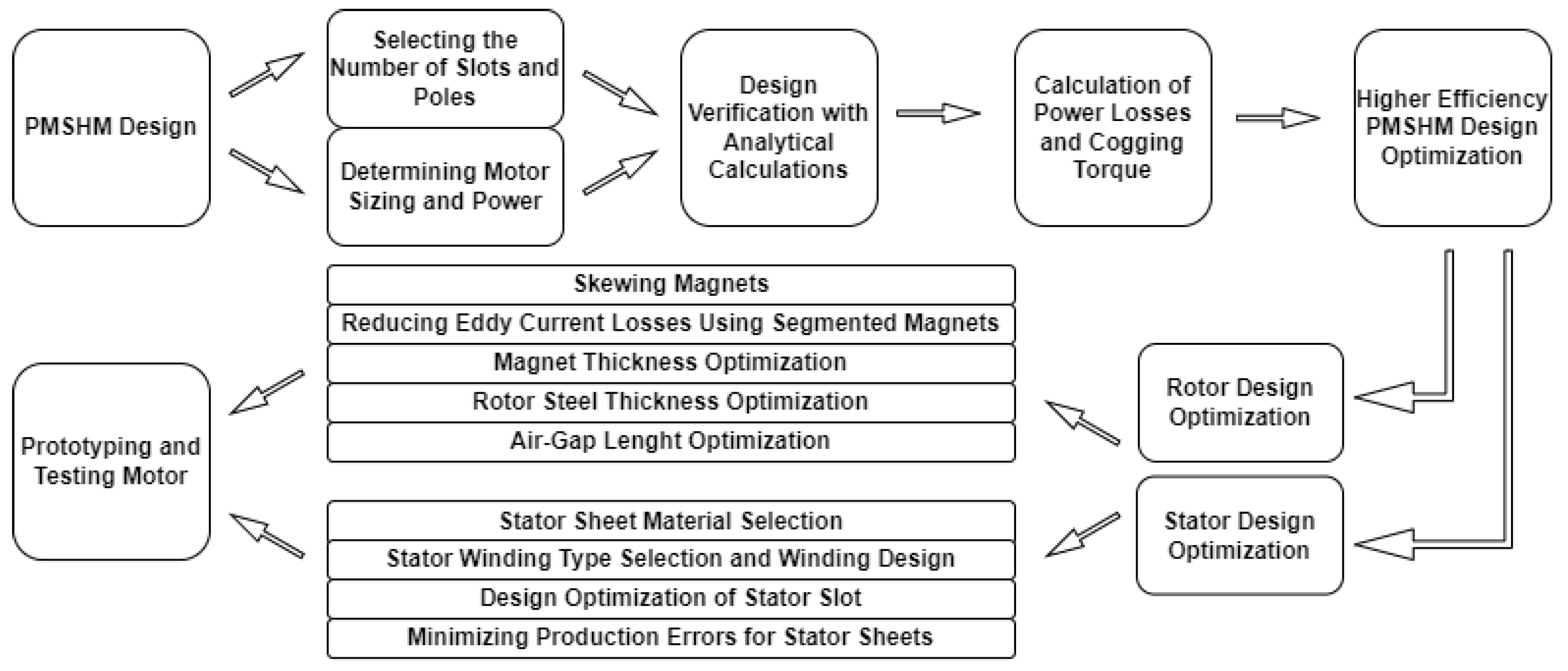






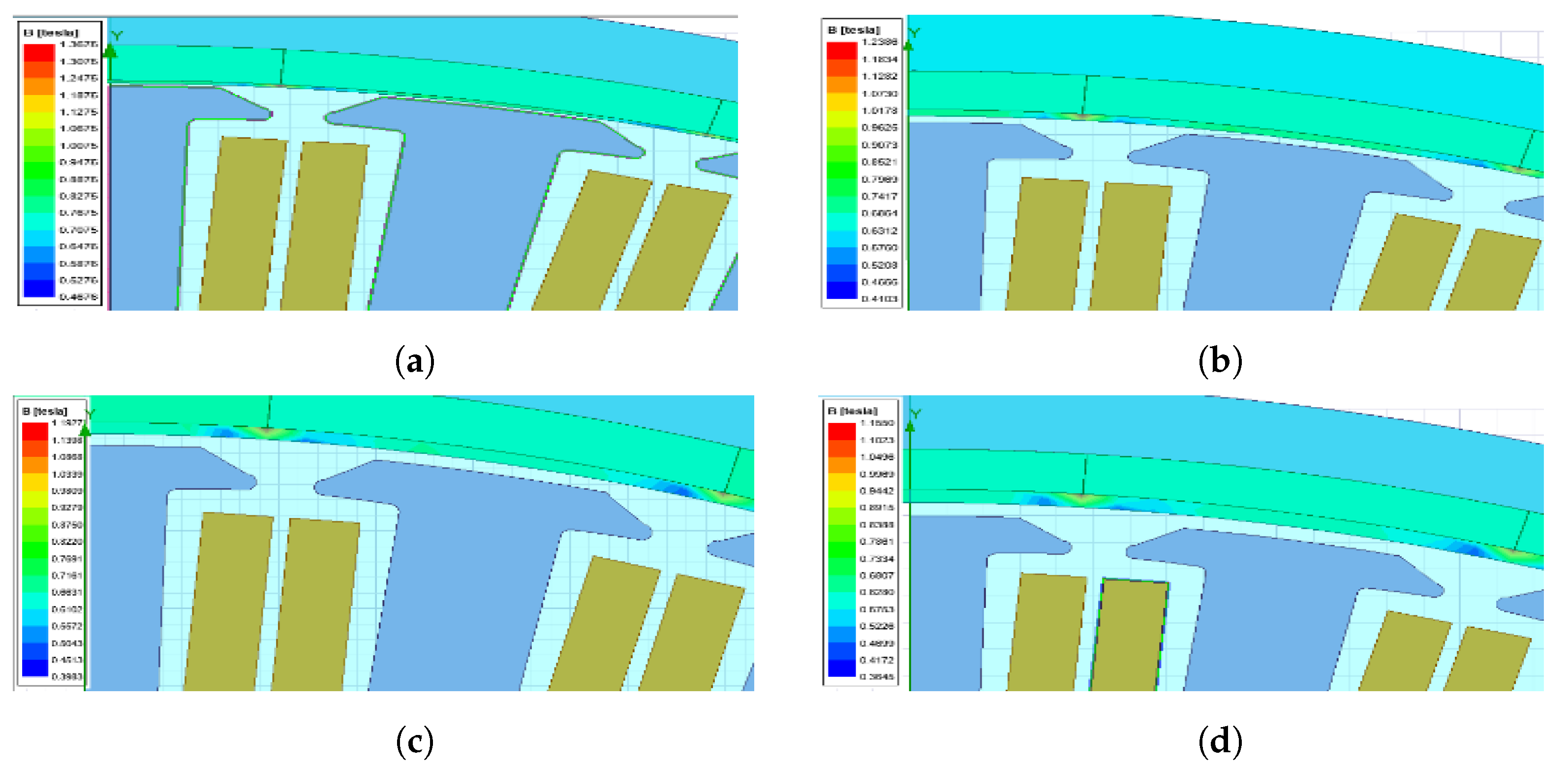
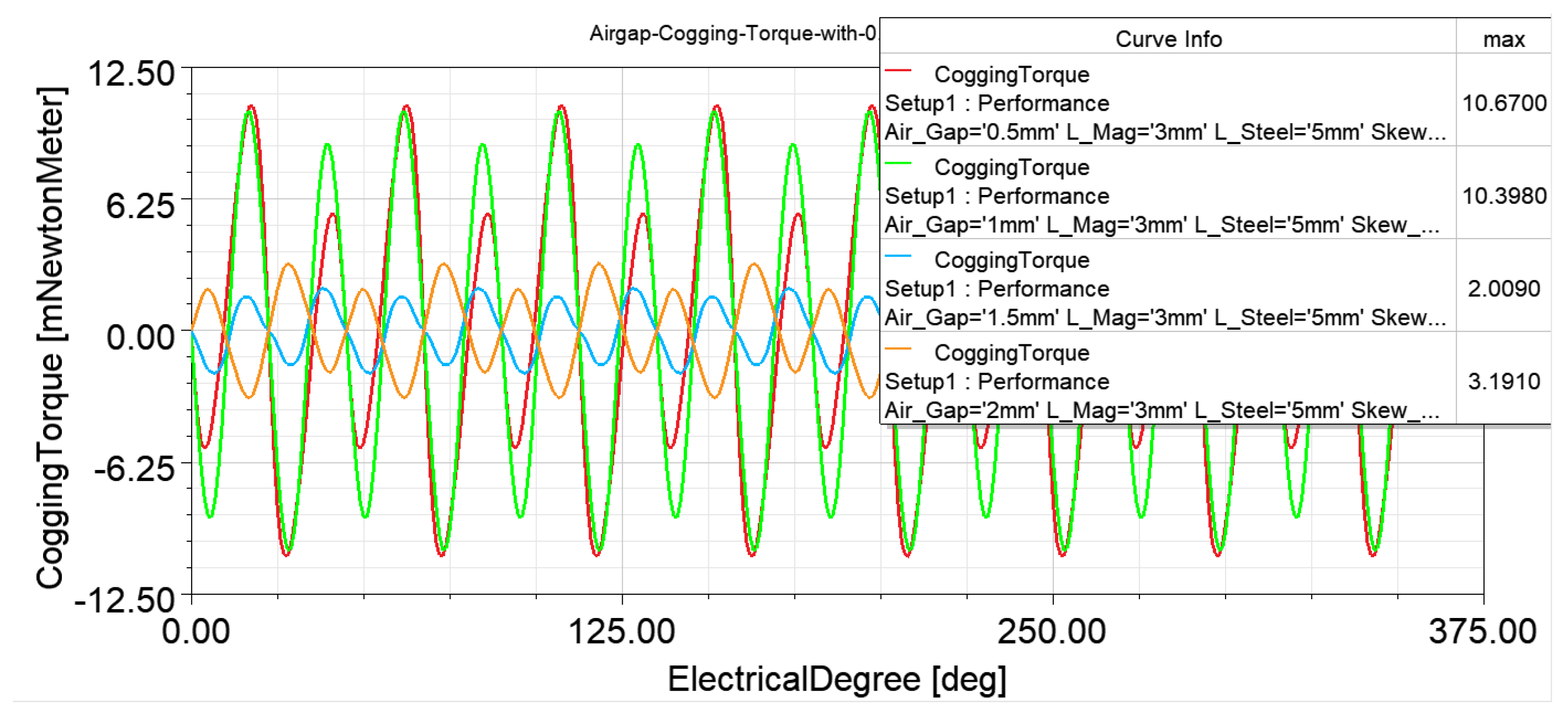
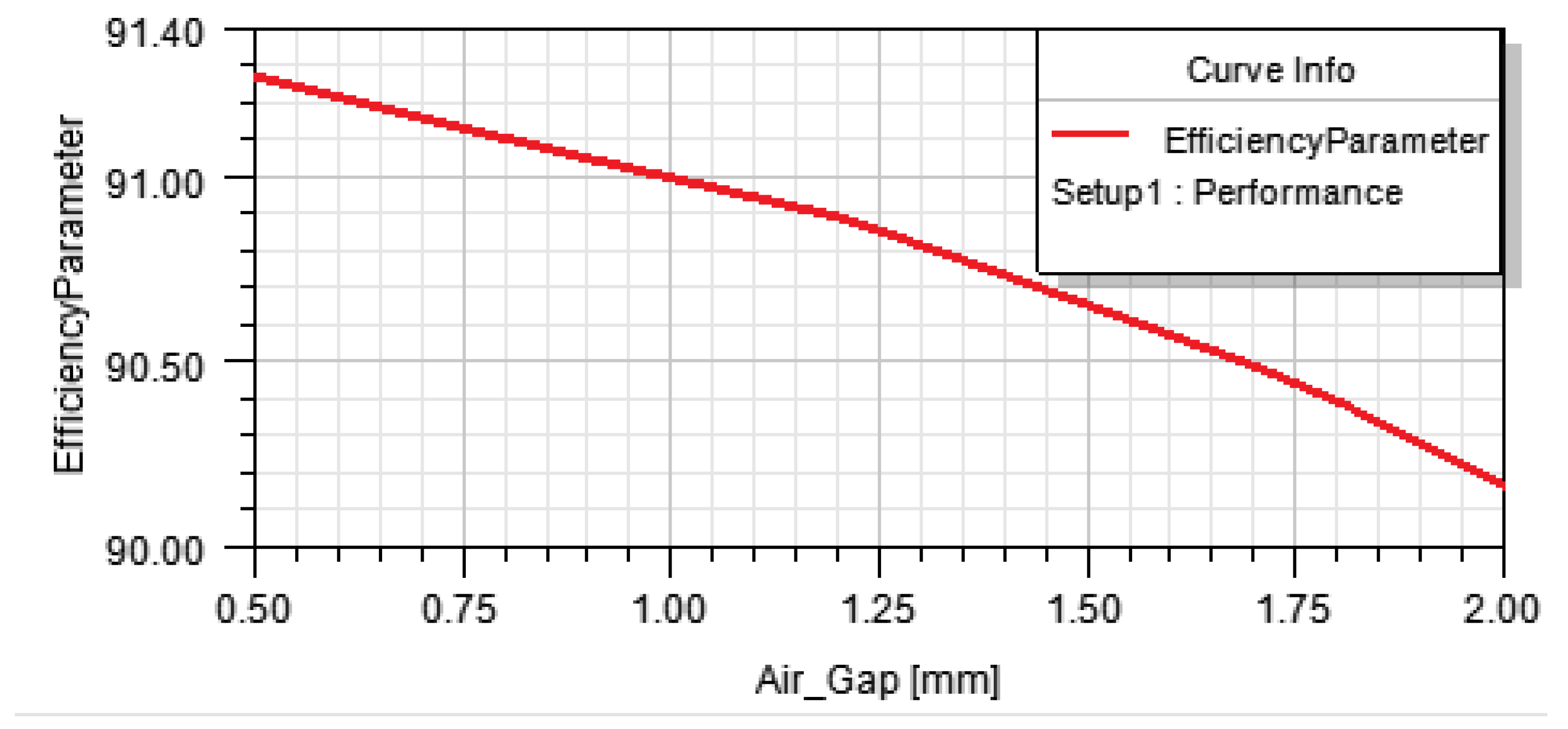


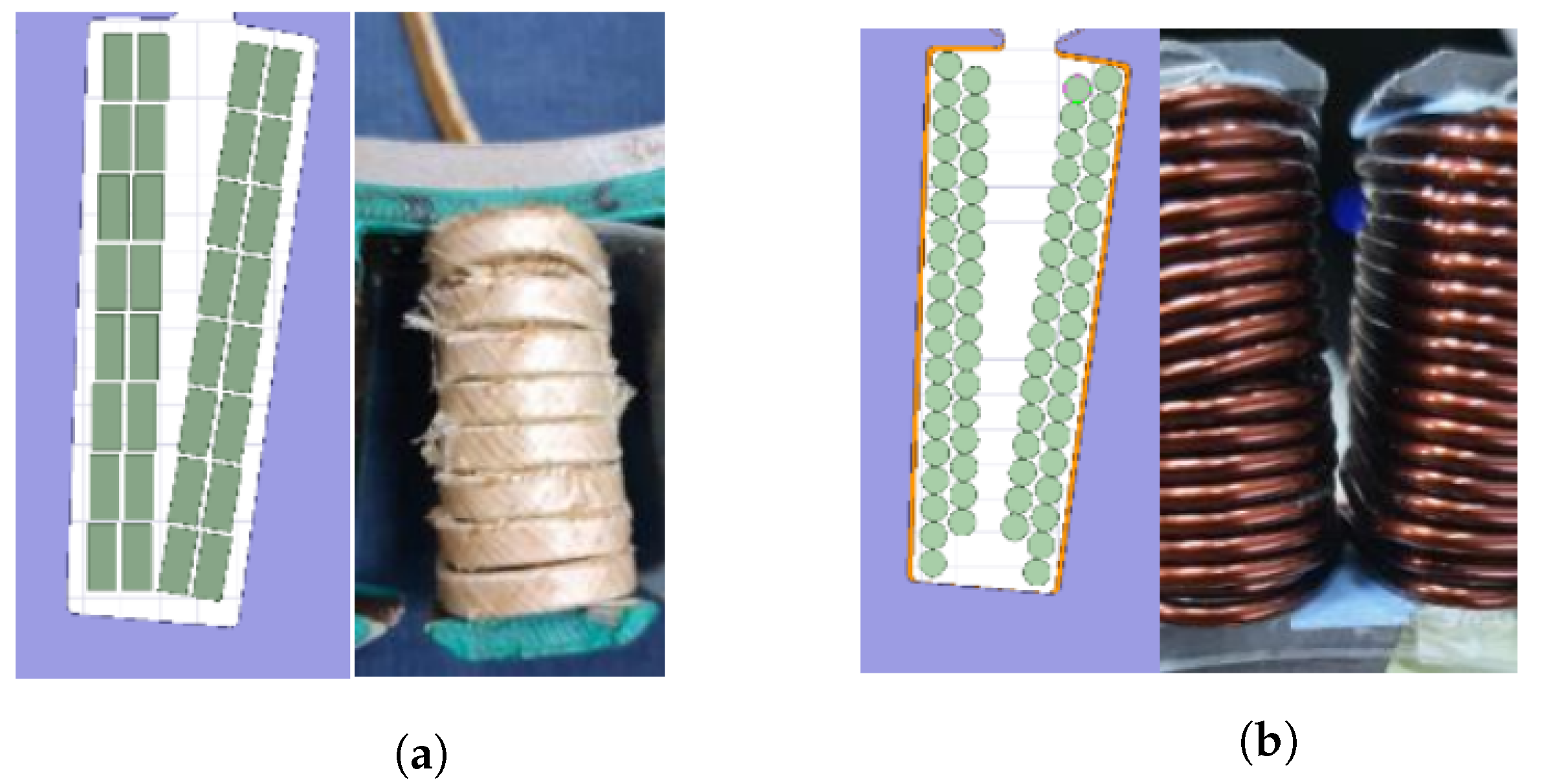
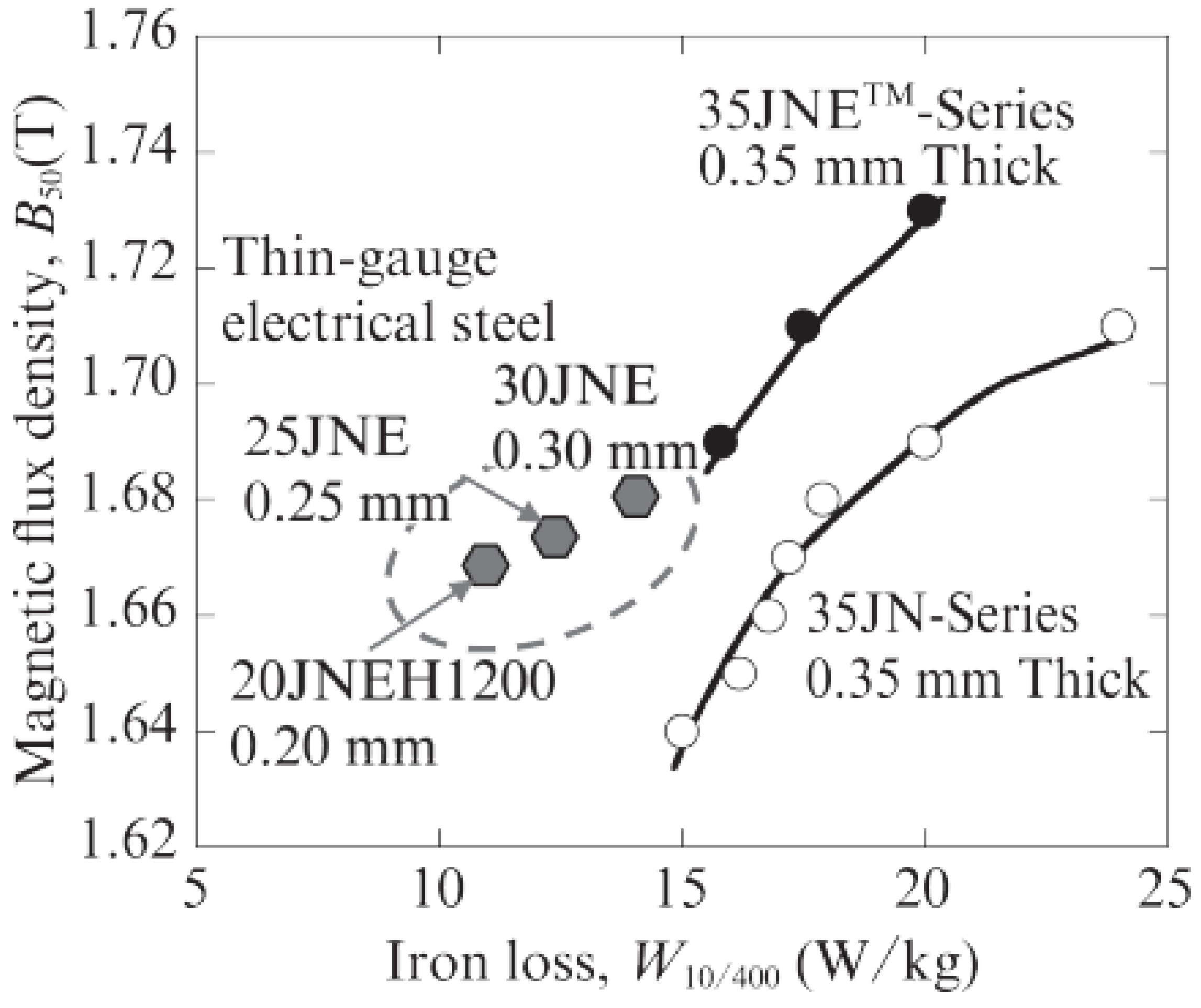
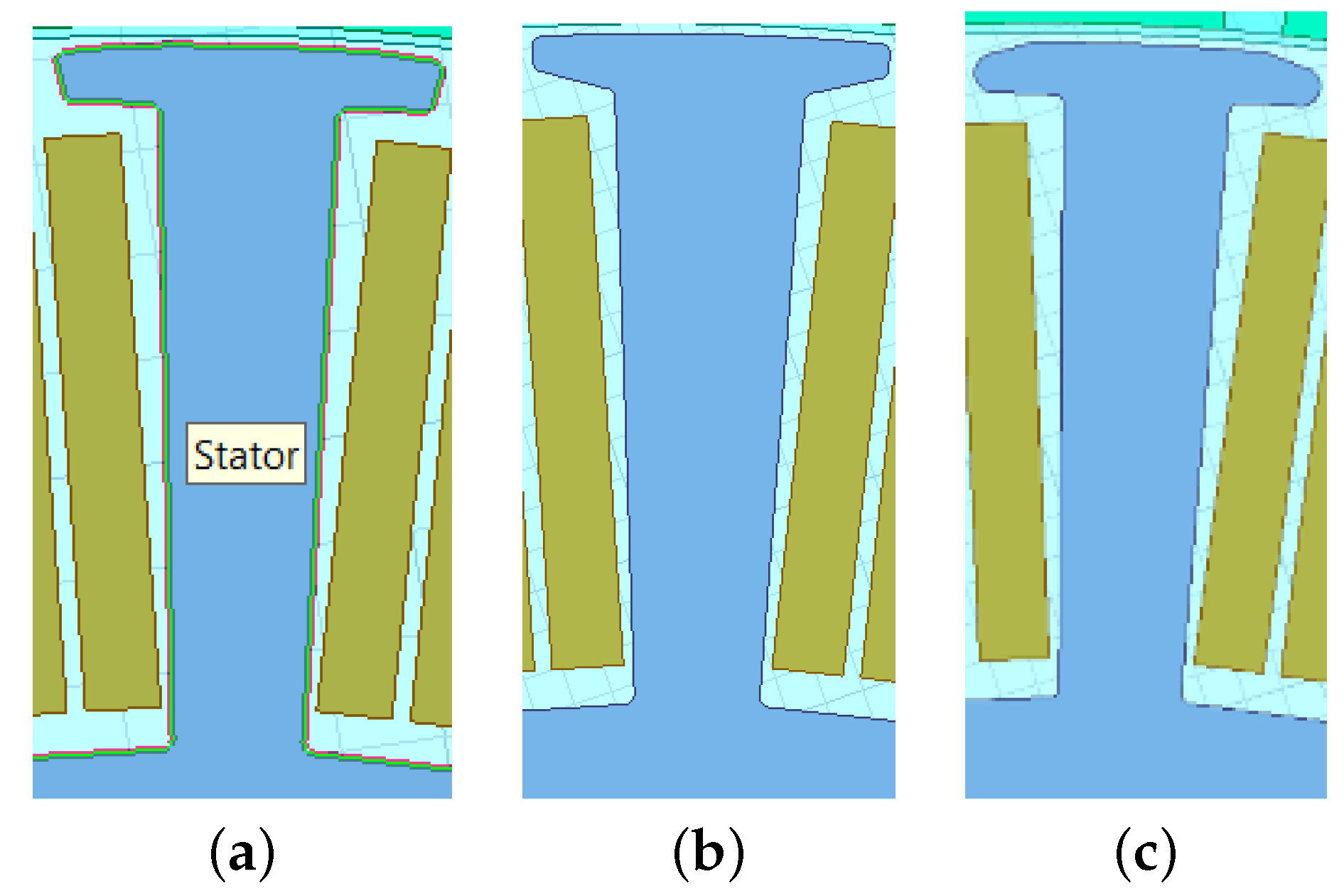


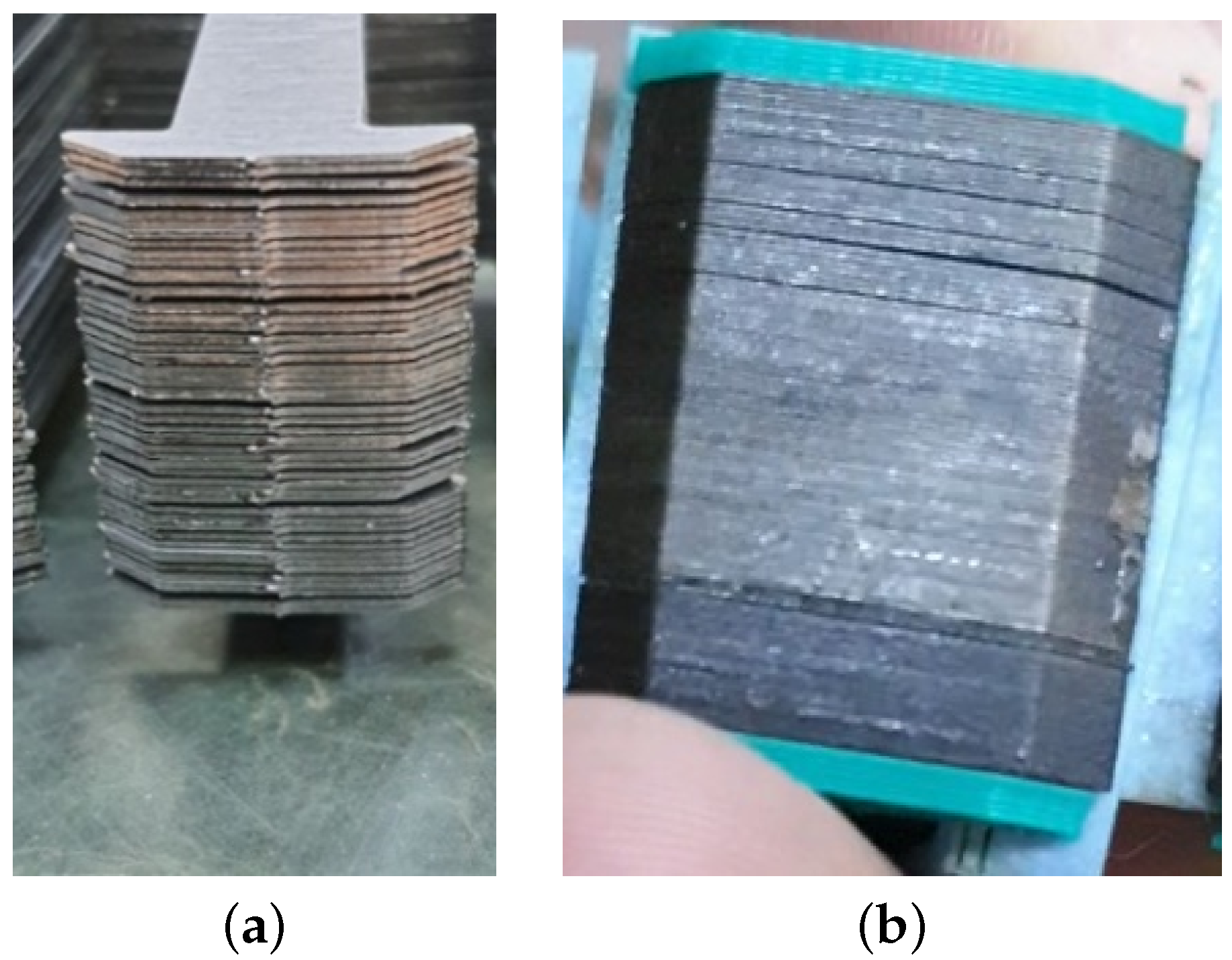
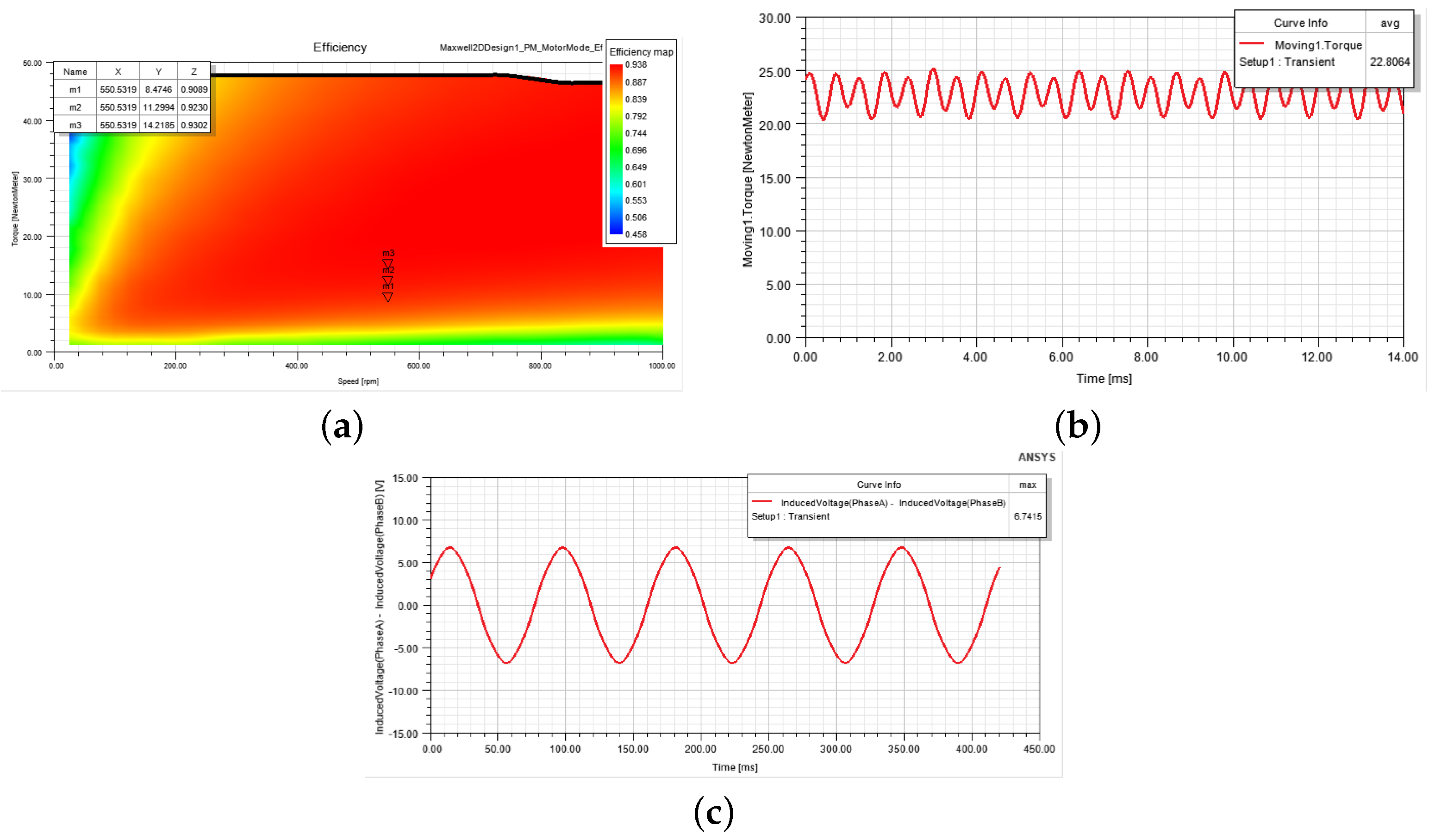
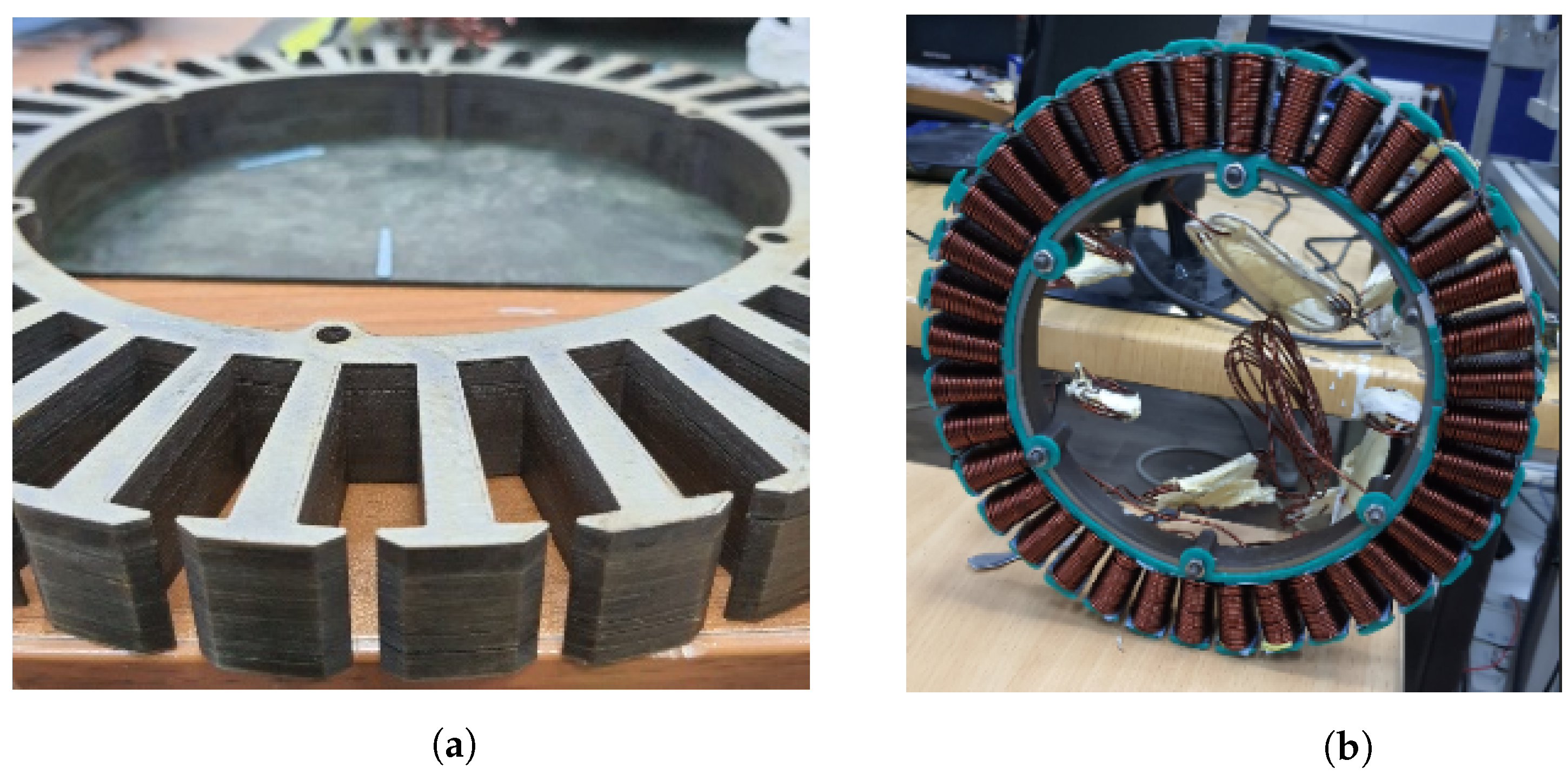
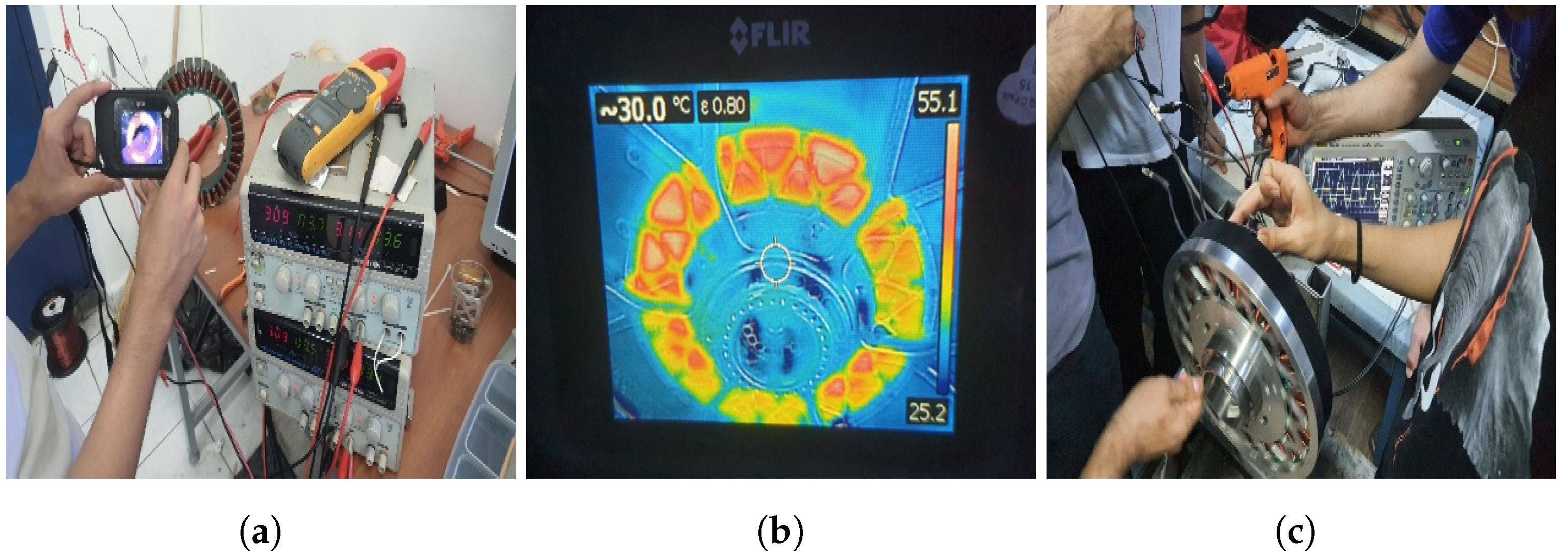

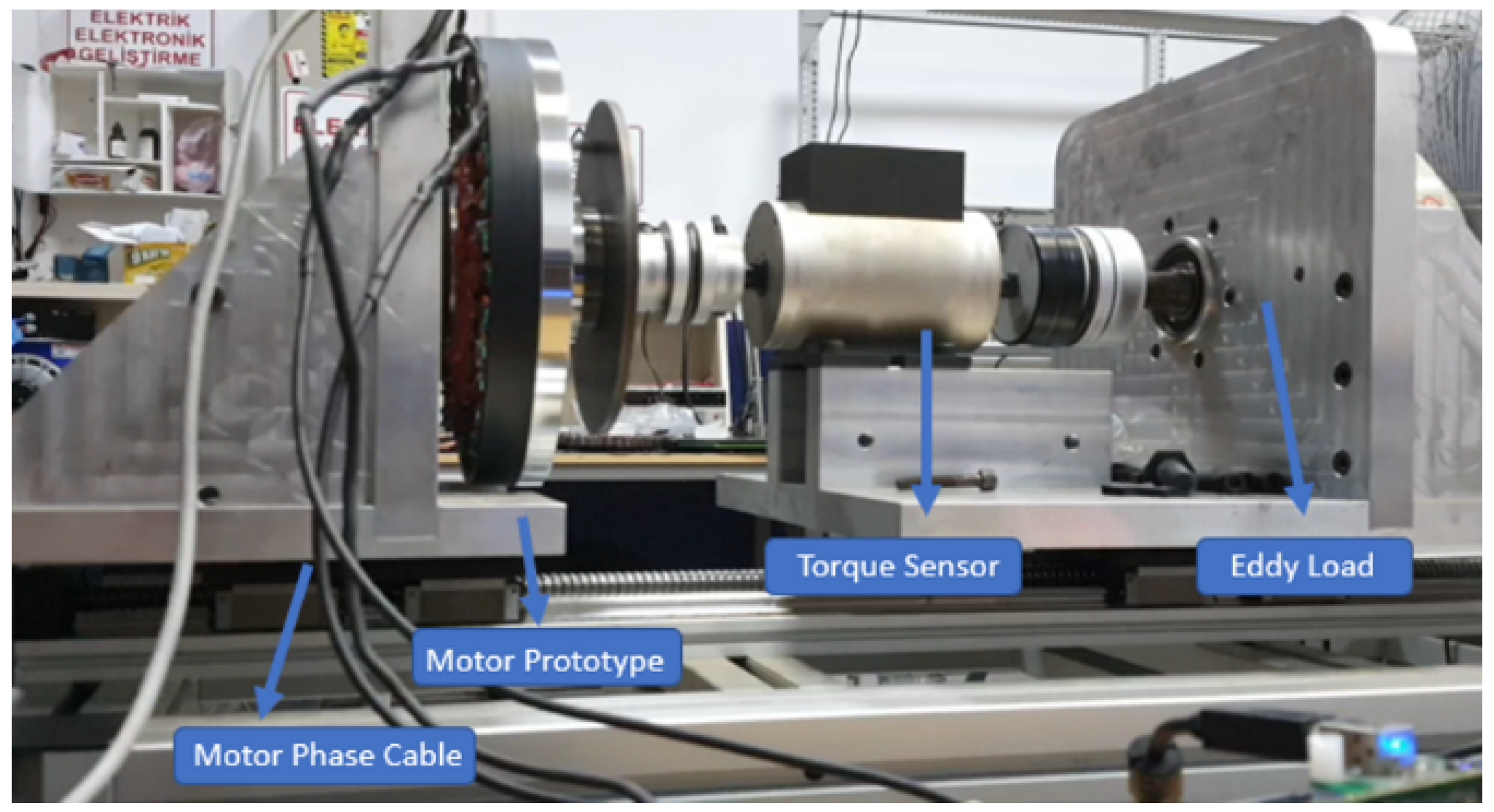
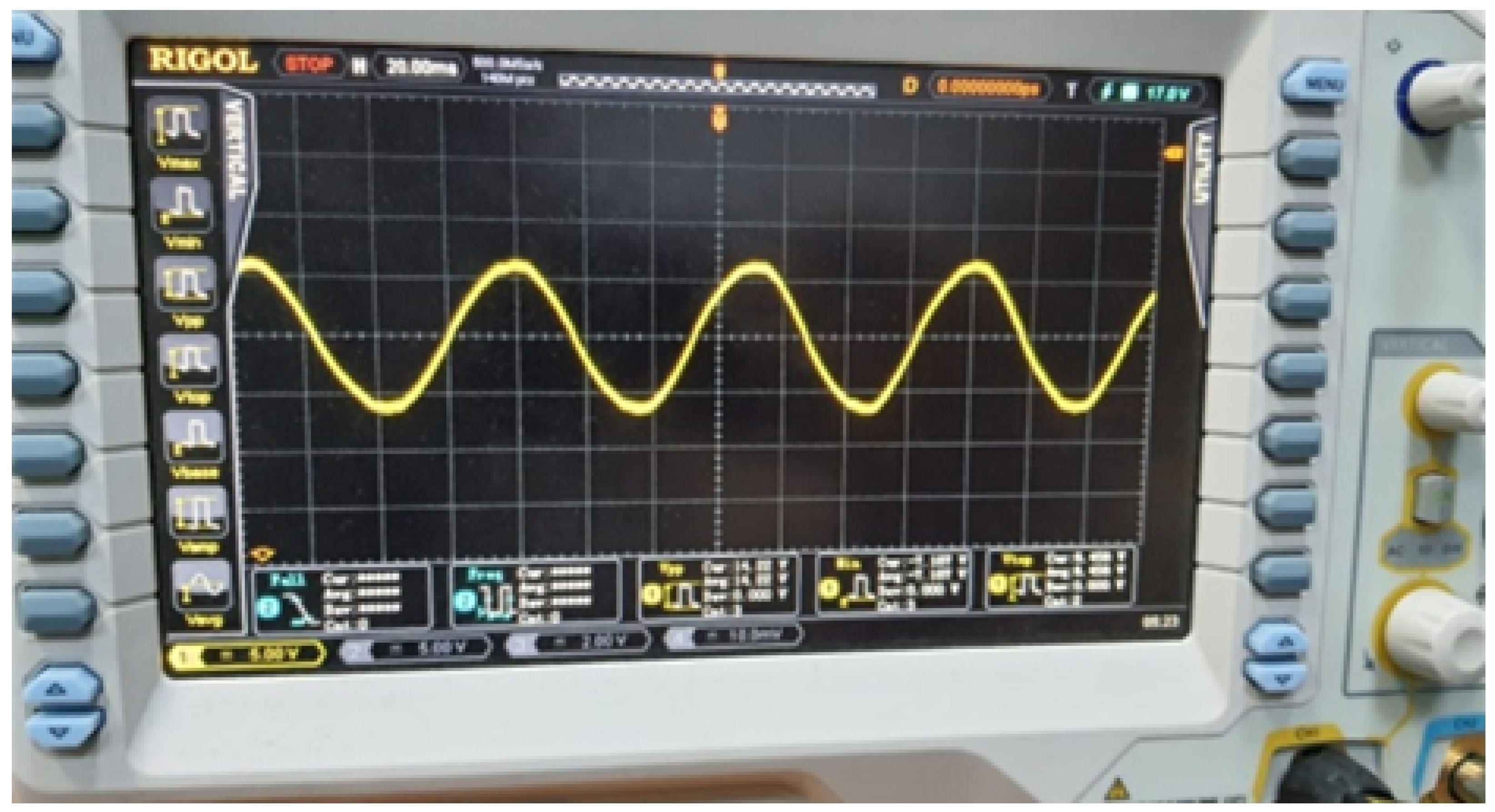
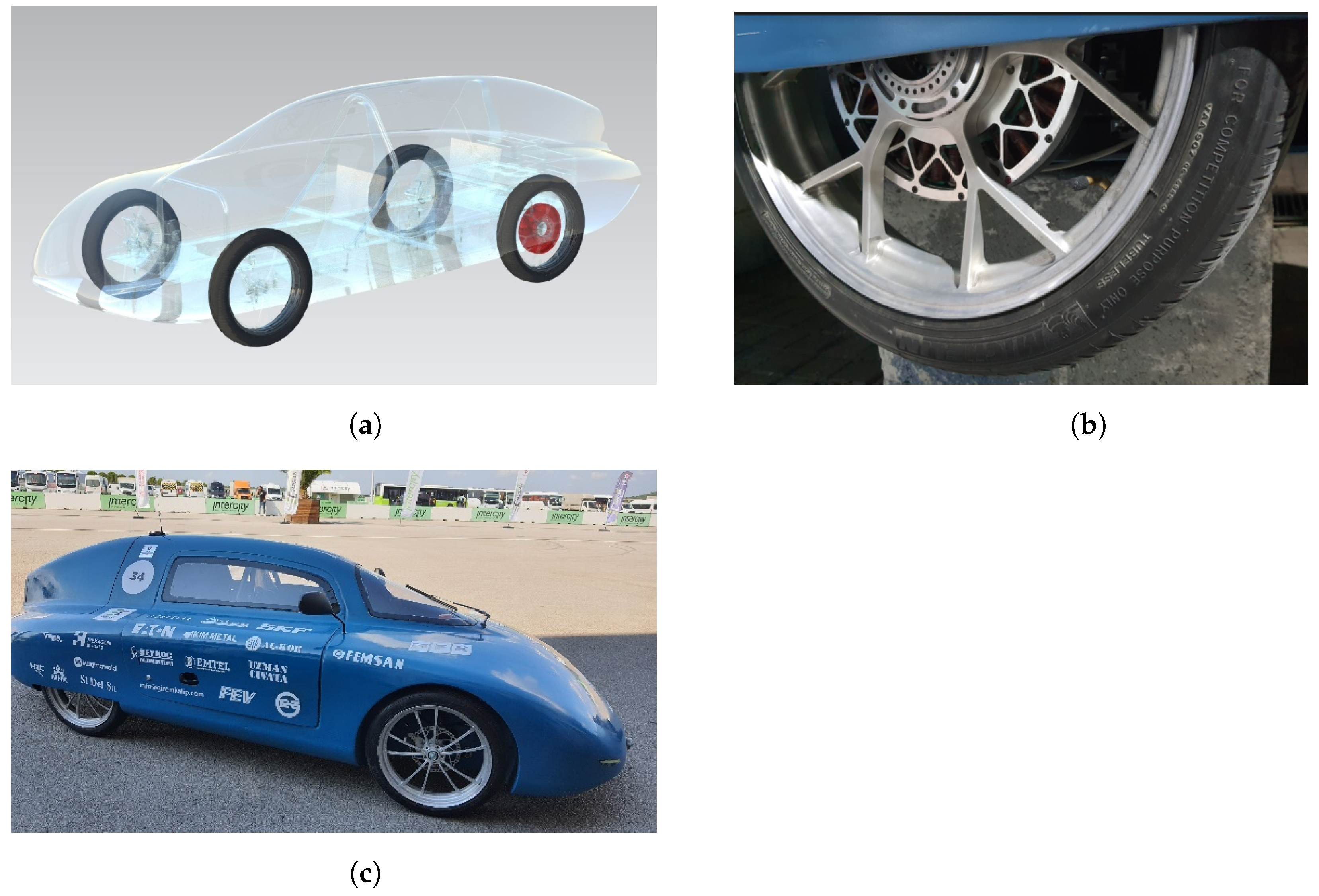
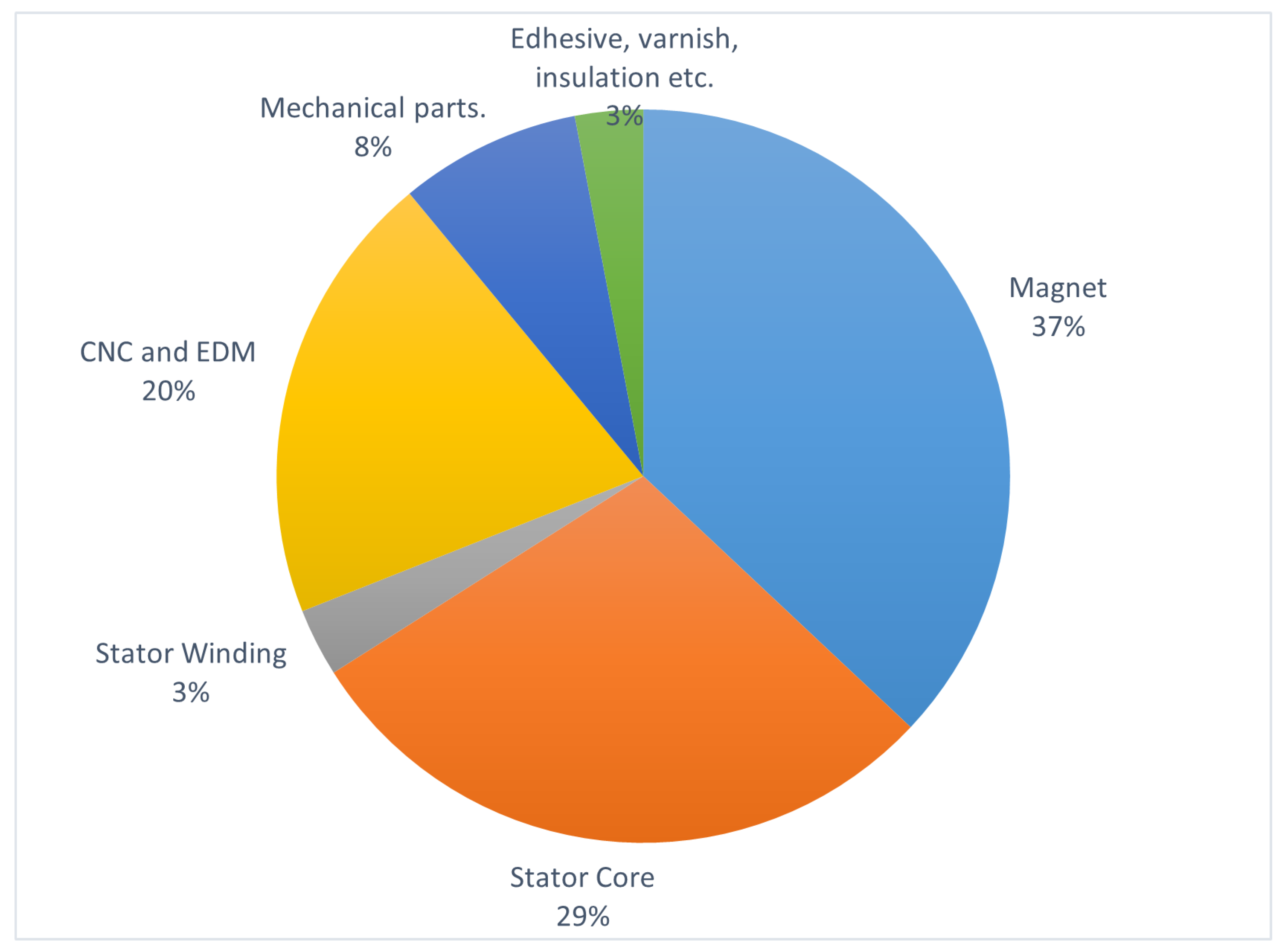
| Motor Characteristics | Unit | Values |
|---|---|---|
| Current (RMS) | A | 14.14 |
| Nominal voltage | V | 96 |
| Nominal speed | r/min | 550 |
| Maximum speed | r/min | 950 |
| Nominal torque | N m | 26 |
| Maximum torque | N m | 50 |
| Nominal power | kW | 1.5 |
| Maximum power | kW | 3.5 |
| Phase Resistance | Ohm | 0.079 |
| Phase Inductance | Henry | 0.00085 |
| Cosϕ | - | 0.97 |
| Geometrical Spec. | ||
| Stator outer diameter | mm | 242 |
| Rotor outer diameter | mm | 260 |
| Stack length | mm | 20 |
| Air gap length | mm | 1 |
| Slot teeth width | mm | 17.6 |
| Magnet radial length | mm | 23.9 |
| Magnet thickness | mm | 3 |
| Winding Spec. | ||
| Number of slots | - | 36 |
| Number of poles | - | 32 |
| Number of turn | - | 16 |
| Number of phases | - | 3 |
| Stator winding factor (k) | - | 0.945 |
| Magnet Data | ||
| Remanent magnetic flux density (B) | T | 1.45 |
| Coersive force (H) | kA/m | 836 |
| Magnet grade | - | NdFeB N52 |
| Steel Spec. | ||
| Electrical steel (stator) | - | 20JNEH1200 |
| Steelback (rotor) | - | C1050 |
| Other Spec. | ||
| Total weight | kg | 6 |
| RPM | Rad/s | Eddy Set Voltage | DC BUS Voltage | DC BUS Current | Efficiency |
|---|---|---|---|---|---|
| 550 | 57.596 | 4 | 95.5 | 2.1 | 81.274 |
| 550 | 57.596 | 4.5 | 95.5 | 2.65 | 84.206 |
| 550 | 57.596 | 5 | 95.5 | 3.32 | 88.103 |
| 550 | 57.596 | 5.5 | 95.5 | 4.11 | 88.043 |
| 550 | 57.596 | 6 | 95.5 | 4.85 | 89.159 |
| 550 | 57.596 | 6.5 | 95.5 | 5.65 | 90.198 |
| 550 | 57.596 | 7 | 95.5 | 6.4 | 92.066 |
| 550 | 57.596 | 7.5 | 95.5 | 7.38 | 92.589 |
| 550 | 57.596 | 8 | 95.5 | 8.34 | 91.911 |
| 550 | 57.596 | 8.5 | 95.5 | 9.32 | 91.694 |
| 550 | 57.596 | 9 | 95.5 | 10.32 | 91.251 |
Publisher’s Note: MDPI stays neutral with regard to jurisdictional claims in published maps and institutional affiliations. |
© 2022 by the authors. Licensee MDPI, Basel, Switzerland. This article is an open access article distributed under the terms and conditions of the Creative Commons Attribution (CC BY) license (https://creativecommons.org/licenses/by/4.0/).
Share and Cite
Çömezoğlu, İ.G.; Zorlu Partal, S. Implementation and Experimental Validation of Efficiency Improvement in PM Synchronous Hub Motors for Light Electric Vehicles. Energies 2022, 15, 7953. https://doi.org/10.3390/en15217953
Çömezoğlu İG, Zorlu Partal S. Implementation and Experimental Validation of Efficiency Improvement in PM Synchronous Hub Motors for Light Electric Vehicles. Energies. 2022; 15(21):7953. https://doi.org/10.3390/en15217953
Chicago/Turabian StyleÇömezoğlu, İrfan Güven, and Sibel Zorlu Partal. 2022. "Implementation and Experimental Validation of Efficiency Improvement in PM Synchronous Hub Motors for Light Electric Vehicles" Energies 15, no. 21: 7953. https://doi.org/10.3390/en15217953
APA StyleÇömezoğlu, İ. G., & Zorlu Partal, S. (2022). Implementation and Experimental Validation of Efficiency Improvement in PM Synchronous Hub Motors for Light Electric Vehicles. Energies, 15(21), 7953. https://doi.org/10.3390/en15217953







